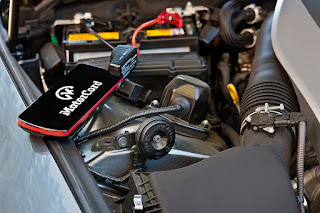Operating Instructions
WARNING:This product features a captive sealed VRLA (valve-regulated lead acid)
battery. It is important that the battery is kept at full charge to ensure maximum
lifespan. Charge immediately on receipt of this product; immediately after use; and
every 1-2 months when not in use.
 WARNING
WARNING: While charging this jump starter it is important that it is not used or
connected to any other device or cable except for either the 230V AC Charger (12)
or 12V Charging Lead (13).
WARNING: This product is not a battery charger. Never connect the 230V AC
charger to the jump starter while the jump starter is connected to a vehicle’s
battery. The jump starter must only be used with the charging cables disconnected
Charging the battery
WARNING:
Over-charging could produce flammable gases
• To check the battery condition press the Battery Test Button (6), ensuring
no external cables are attached to the unit. The battery condition is shown
by the Volt-meter (3). The volt-meter will display an approximate indication
of charge with the green area indicating a sufficient charge. A fully charged
battery should indicate 12.6V or more. A more accurate test can be performed
with a multi-meter using the 20V DC voltage setting or the nearest to it above
that range.
• The battery should be charged at 20°C (room temperature)
• Ensure there are no naked flames or other ignition sources near to the
charging area
Charging from 230V supply
1. Insert the small plug of the 230V AC Charger (12) into the Charging Socket (7)
2. Insert the 230V AC charger into a mains socket, check that the socket is
switched on
• For the initial charge, allow up to 40 hours but regularly check the battery
charge indicator. For a normal top-up charge allow up to 10 hours
• Ensure the charging area is well ventilated with no open flames or high
temperature surfaces, such as a hob, in the vicinity
Charging from a 12V car cigarette lighter socket
Charging from the cigarette lighter socket of your vehicle while in motion is
a convenient way of topping up the charge of your jump starter. However the
jump starter must be positioned in the rear of the vehicle while charging and
the car must be well ventilated. If this isn’t possible, only use the AC charging
method. When charging in the car, regularly check the charge level to prevent
over-charging.
1. Plug the 12V Charging Lead (13) into the Charging Socket (7)
2. Insert the cigarette lighter plug of the 12V charging lead into a suitable car
cigarette lighter socket
3. A 12V car cigarette socket extension lead may be required if there is no
socket in the rear of the car and need to extend the cable from the cigarette
lighter socket in the dashboard
4. Only charge until the the Volt-meter (3) indicates a sufficient charge. Check
the meter every 45 minutes to 1hr to prevent over-charging. Initial charge may
take up to 12hrs and top up charges may take as little as 1hr after being used
Notes:
• Some cars provide a cigarette lighter socket on the dashboard and in the
boot/rear of the car. It is important that the cigarette lighter socket is disabled
when the ignition is switched off otherwise the jump starter can drain the
main battery when parked
• If you choose to charge the jump starter with a cigarette socket in the rear of
the vehicle, it is important to remember not to leave the battery permanently
charging and only charge until a sufficient charge is indicated on the voltmeter.
This is more critical with a 12V charging connection as the charge level
is higher than with the AC charger
• If the jump starter has just been used to start a vehicle, allow 15 minutes
before charging the jump starter in a vehicle, to allow the battery to stabilise
and any flammable vapours to disperse
IMPORTANT: Failure to follow the correct procedure when charging the jump
starter will result in permanent damage.
Jump starting
Notes:
• Always refer to vehicle handbook before using this product. If the
manufacturer specifies a particular sequence for jump starting, follow the
manufacturer’s advice
• Follow normal starting procedures with regard to pre-charging glow plugs etc,
• Do not attempt to use this product on anything other than 12V negative earth
vehicle electrical system





